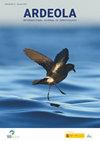Low-Intensity Landscaping of Research Facilities Increased Taxonomic, Functional and Phylogenetic Bird Diversity in a Lowland Rainforest
IF 1.2
4区 生物学
Q2 ORNITHOLOGY
引用次数: 3
Abstract
Summary. Bird communities inhabiting tropical rainforests are sensitive to changes in vegetation structure, either natural (e.g. treefalls or landslides) or man-made. Natural changes tend to increase diversity and abundance, whereas anthropic changes often have the opposite effect. We analyse how landscaping for the creation of research facilities influenced the taxonomic, functional and phylogenetic diversity of bird communities in a Caribbean coastal rainforest of Costa Rica, and whether diversity changes were mediated by changes in vegetation structure. Bird communities were sampled by means of mist nets located in the landscaped areas and in paired sites of the nearby rainforest during three consecutive dry seasons (2017-2019). Vegetation structure around each net was also recorded. Forest openness and degree of development of the tree layer led to more abundant and species-rich assemblages in both the managed and the non-managed sites. Functional diversity of several key traits (diet, beak shape, manoeuvrability and foraging site) was favoured by the degree of development of the tree layer in managed sites and by those of the shrub layer in the forest. Beta diversity analyses showed that increased diversity in managed areas was due to a higher presence of species linked to naturally cleared forest areas already present in the forest, rather than to a substitution of a species-poor forest assemblage by a species-rich open-land community. Overall, we show that low-intensity disturbance linked to the creation and maintenance of research facilities can favour the conservation of richer and functionally diverse bird communities, at least in species-rich secondary rainforests, as long as a well-developed tree layer is maintained in the cleared areas.—Aycart, P. & Díaz, M. (2021). Low-intensity landscaping of research facilities increased taxonomic, functional and phylogenetic bird diversity in a lowland rainforest. Ardeola, 68: 355-371.研究设施的低强度景观美化增加了低地雨林鸟类的分类、功能和系统发育多样性
总结。栖息在热带雨林中的鸟类群落对植被结构的变化非常敏感,无论是自然的(如树木砍伐或山体滑坡)还是人为的。自然变化倾向于增加多样性和丰度,而人为变化往往产生相反的效果。本文分析了哥斯达黎加加勒比海沿海雨林中为建立研究设施而进行的景观美化如何影响鸟类群落的分类、功能和系统发育多样性,以及多样性变化是否受到植被结构变化的调节。在连续三个旱季(2017-2019年),通过位于景观区和附近雨林成对地点的雾网对鸟类群落进行采样。还记录了每个网周围的植被结构。森林的开放程度和乔木层的发育程度导致受管理和未受管理的样地群落更丰富、物种更丰富。人工林中乔木层的发育程度和灌丛层的发育程度对几个关键性状(食性、喙形、机机性和觅食地点)的功能多样性有利。Beta多样性分析表明,受管理地区的多样性增加是由于与森林中已经存在的自然砍伐林区有关的物种较多,而不是由于物种丰富的开阔地群落取代了物种贫乏的森林群落。总的来说,我们表明,与研究设施的建立和维护相关的低强度干扰可以有利于保护更丰富和功能多样化的鸟类群落,至少在物种丰富的次生雨林中,只要在清除区域保持良好的树木层。-艾卡特,P. & Díaz, M.(2021)。研究设施的低强度景观美化增加了低地雨林鸟类的分类、功能和系统发育多样性。中国生物医学工程学报,68:355-371。
本文章由计算机程序翻译,如有差异,请以英文原文为准。
求助全文
约1分钟内获得全文
求助全文
来源期刊
CiteScore
2.30
自引率
6.20%
发文量
16
审稿时长
>12 weeks
期刊介绍:
Ardeola: International Journal of Ornithology is the scientific journal of SEO/BirdLife, the Spanish Ornithological Society. The journal had a regional focus when it was first published, in 1954. Since then, and particular during the past two decades, the journal has expanded its thematic and geographical scope. It is now a fully international forum for research on all aspects of ornithology. We thus welcome studies within the fields of basic biology, ecology, behaviour, conservation and biogeography, especially those arising from hypothesis-based research. Although we have a long publication history of Mediterranean and Neotropical studies, we accept papers on investigations worldwide.
Each volume of Ardeola has two parts, published annually in January and July. The main body of each issue comprises full-length original articles (Papersand Review articles) and shorter notes on methodology or stimulating findings (Short Communications). The publication language is English, with summaries, figure legends and table captions also in Spanish. Ardeolaalso publishes critical Book Reviewsand PhD-Dissertation Summaries; summarising ornithological theses defended in Spain. Finally there are two Spanish-language sections, Ornithological News; summarising significant recent observations of birds in Spain, and Observations of Rare Birds in Spain, the annual reports of the Spanish Rarities Committee.

 求助内容:
求助内容: 应助结果提醒方式:
应助结果提醒方式:


